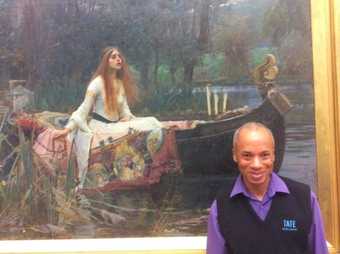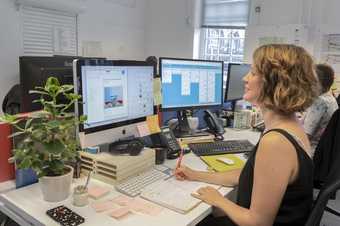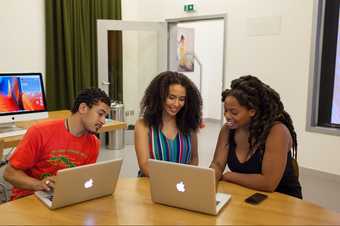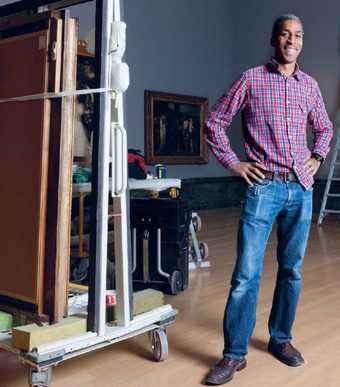
Mikei Hall in Tate Britain © Tate Photography
What does your job involve?
My job is to install the art on display at Tate Britain including displays, exhibitions, and special projects. This involves unpacking, moving, handling as well as installing artworks.
What qualifications, knowledge, skills, experience or interests do you need for your career?
I have always been interested in art and design. As a child I was always drawing and making things and also liked to understand how things worked. I used to make things from the stuff I found around me. Once my mum came home to find that I had emptied all the washing up liquid from a bottle and used the bottle to make a rocket!
I studied A Level art and at that time thought I would like to study furniture design. I did a course at what was then London College of Furniture on Commercial Road in London which provided an introduction to interior design and furnishings and taught skills such as technical drawing. But I couldn’t immediately find a job when I left. After going to a job centre that specialised in arts jobs I was selected to be included in a radio programme on LBC about skilled people who were having problems finding work. The programme was heard by someone who owned a furnishings company and who offered me a job in his company as a design assistant. I worked there for three years, but unfortunately the company suffered financial difficulties and folded. I then managed to get a job in a company that made props for adverts, because I was good at making things.
An artist friend asked me one day if I knew anyone who would be able to make a glass shelf as part of an artwork. I told him I could do that, and after that it snowballed, with other artists asking me to construct things for them. This gave me experience and skills that proved to be relevant and useful in applying for my current role at Tate.
What attracted you to this job at Tate?
When I saw that Tate was advertising for a technician, I thought I would apply as it would be good experience to work somewhere like that for a while. My plan was to learn as much as I could for two years and see if I could help my artistic practice…I had no idea I would still be here twenty-five years later!
As I liked, and had experience, fabricating things; and was also interested in art and design, the job meant I could combine my skills and experience with my interest in art.
Briefly describe a typical working day
I am involved in the planning of the installs of exhibitions and displays as well as the actual installing and de-installing.
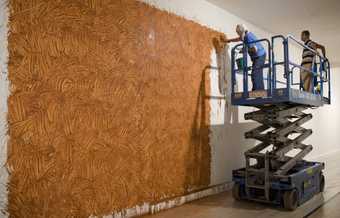
Mikei with artist Richard Long as he installs his wall drawing From Beginning to Endfor his 2009 exhibition at Tate Britain
There is lots of forward planning. Once a week all the people involved in exhibitions and displays meet to discuss the programme for the next week and who will do what. There are then site visits and project team meetings.
Most days are then spent in the galleries installing, de-installing or moving work, but there aren’t really typical days in that the programme changes and we will be handling lots of very different types of artworks – from paintings to complicated installations (such as Mike Nelson’s Coral Reef). Also, there might be unexpected things to do: a curator or artist may want to meet informally to chat about aspects of an installation, or I may be called to fix an unforeseen issue…such as replacing a projector bulb.
What are the most rewarding and most difficult things about your job?
The most rewarding thing is having the challenge of installing something: working out how to do it; and then seeing the finished result and knowing that you have been part of that…it’s a great sense of pride and achievement, especially if it is something quite complicated. The most challenging projects are the Duveen and Art Now commissions, because they are new work and often the first time the work will be fabricated is when we install it.
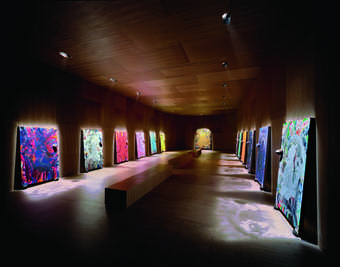
Chris Ofili The Upper Room (Installation, Victoria Miro Gallery, June 2002) 1999–2002
Image courtesy Victoria Miro Gallery, London. Photo: Lyndon Douglas © Chris Ofili
I remember when I worked on Chris Ofili’s Upper Room, it was such an amazing feeling seeing it finished. Partly because it was an ambitious project – and looked really impressive but also because of what the work is about and the meanings behind the work and knowing that I helped get that work seen and that message across.
The job is still interesting to me because it never feels like I’ve ‘seen it, done it’. For example Tate is starting to acquire African and Asian art – that’s a whole new area to learn about. It’s the challenging environment, diversity, and not knowing what’s coming next that drives me. Alongside the hard work it’s also fun – I work with a great team of people.
The most difficult thing is the stress: we work to deadlines, and often have a quick turnaround for quite complicated projects or installations. As Senior Art Handler I have to make sure that everything runs smoothly and according to the schedule.
Also some tasks can be mundane – such as unpacking lorries or removing the packaging from artworks – but it has to be done!
What advice would you give to someone interested in a career in art handling?
It's a fun job, an interesting one and one in which you learn a lot of new things.
To get the most out of it you have to be someone who likes a challenge and enjoys problem-solving, thinking of solutions and is interested in learning new skills. You also have to someone who can deal with the fact that every day is different, and unexpected challenges may be thrown at you. You have to be able to troubleshoot. You will need to be practical, good at making things and have technical skills. You also have to be prepared to work hard…if you do that it is a good career path. It helps if you like art and are interested in it.

